Shanghai's Bund Traders
The Captain's
travels have always been far-reaching. In fact, Hemingway
once warned him over a beer and cigar: "Leave Africa
to me, son."
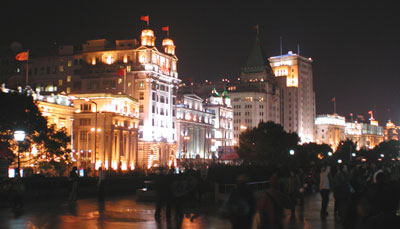 This
week the
Captain finds himself haggling with peddlers on a Shanghai
riverbank. Get there early - the watches with hands rotating
clockwise go fast...
This
week the
Captain finds himself haggling with peddlers on a Shanghai
riverbank. Get there early - the watches with hands rotating
clockwise go fast...
Not one tourist is spared.
"Rolex?" questions a young, slender
man in his thirties, tobacco-stained front teeth and hands
moving through his outer jacket pockets.
It is an evening on the riverbank promenade
of the Bund - Shanghai's strip of historic art deco buildings
aligned along the curve of the murky brown Huangpu River.
Drink and film kiosks battle for customers busily snapping
photos of the recently constructed towers and high-rises on
the opposite bank. In between peddlers cruise the area in
search of targets.
"Cheap, cheap," he declares from
underneath three layers of jackets, ostensibly necessary for
the storing of his faux
merchandise - his Rolexes, Breitlings, and Omegas, all
shiny and attached to black plastic bands. The recommended
Rolex rests in his palm. "Eighty yuan."
When his price - the equivalent of around ten
dollars - is turned down, he quickly counters with alternatives.
"Ladies' Rolex?" he asks, whipping out a smaller,
more compact version of his initial offer as swiftly as a
magician might produce a coin from between his fingers.
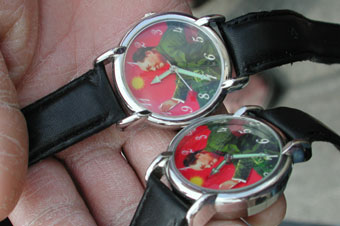 As
the ante is upped with pens and wallets, an elderly woman
with gray, frizzy hair approaches holding two watches with
faces featuring a green-suited Chairman Mao in profile. She
quickly elbows aside the younger vendor.
As
the ante is upped with pens and wallets, an elderly woman
with gray, frizzy hair approaches holding two watches with
faces featuring a green-suited Chairman Mao in profile. She
quickly elbows aside the younger vendor.
"Look, look," she enthuses in her
best raspy English as she begins winding one of the timepieces'
side wheels. As she does, the right arm of the Chairman's
caricature quickly pivots back and forth at the elbow in a
waving motion and the red star-tipped seconds hand begins
sweeping clockwise around a red sky backdrop.
When the Chairman's arm inexplicably stops
moving, she curses in her native Chinese language and momentarily
hunches over, slapping its steel back with her index finger.
By the time she straightens up with her again-waving Mao,
her customer has lost all interest.
Such are the frustrations of capitalism.
"It's all about money now," says
Xie You Yu, a 47-year old postal worker who works the riverbank
in his part time selling personalized paper silhouettes. "Everyone
is just trying to get money off people."
Welcome to Shanghai, arguably Asia's hottest
city. Even with socialism setting political direction - as
has been the case for a half-century - economic reforms carried
out in recent years have brought Shanghai wads of foreign
cash, setting cranes and concrete in motion in such a frenzy
as to result in a metropolitan blend of Las Vegas and a George
Orwell dream. The view of today's Shanghai by the flim-flam
men on the promenade, however, is much simpler: more foreign
investment means more foreign suckers.
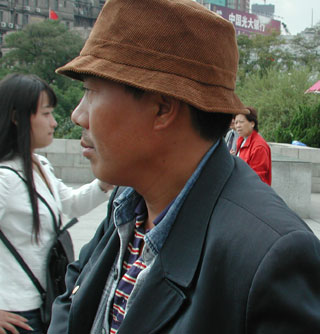 In
his blue postal jacket and brown corduroy hat, the gray-whiskered
Xie takes a seat on a concrete bench in a park just below
the promenade. He kills time waiting for arriving tour buses
by practicing his craft.
In
his blue postal jacket and brown corduroy hat, the gray-whiskered
Xie takes a seat on a concrete bench in a park just below
the promenade. He kills time waiting for arriving tour buses
by practicing his craft.
He starts by folding a small slip of paper
in half. An edge is selected and he begins cutting both halves
simultaneously with a small pair of scissors. His left thumb
and index finger act as a pivot point as he carefully trims
out the main curves of a human profile and its small details
- nose, hairline, chin and lips. A paper display frame, decorated
on both sides with colorful stripes and Chinese characters
around the edges, is used to display the two resulting postage
stamp-size pieces.
"Westerners are easier to cut because
they have more prominent features compared to Asians,"
explains the 19-year veteran cutter after producing a sample
piece complete with a large chin and pompadour.
Xie's primary target is the Japanese tourist.
Though he has never been to Japan, he speaks nearly fluent
Japanese, a skill he learned from listening to a feed of Japan's
national broadcast station NHK.
"I speak Japanese and feel comfortable
talking the price up to 100 yuan with them (the Japanese),"
he says of his negotiating. "But for Europeans or Americans
I take what I can get, maybe 10 yuan."
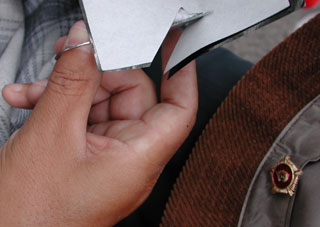 The
merchandise dealers are less particular, chasing nearly anyone
who looks willing to relieve his wallet of 50 or 100 yuan
for, say, a Chairman Mao special, which, as Xie informs, is
supplied to the peddlers by 10 to 12 outlets around Shanghai
for 15 yuan.
The
merchandise dealers are less particular, chasing nearly anyone
who looks willing to relieve his wallet of 50 or 100 yuan
for, say, a Chairman Mao special, which, as Xie informs, is
supplied to the peddlers by 10 to 12 outlets around Shanghai
for 15 yuan.
Xie claims that there were times a few years
ago when the traders - which today number around 100 on any
given day - primarily sold small stone carvings but later
switched when they realized it is easier to swindle tourists
with phony watches, Mont Blanc pens, and Louis Vuitton wallets.
The selling of these wares has technically
become illegal, Xie notes, with fines and jail time resulting
for transgressors caught in the act. And indeed, the occasional
wail of a policeman's siren causes all the hawkers to scatter.
Xie, however, never even flinches. "This is art,"
he boasts of his work.
Xie's arrival in the park is usually by mid-morning,
soon after his duties of driving a postal truck are finished.
He then starts studying the arriving tour buses; Korean, Taiwanese,
and European tour groups are easily identifiable with a mere
glance. He even can tell which buses are arriving from Beijing
- useful information since he knows that such travelers will
have already become weary of salesmen like him.
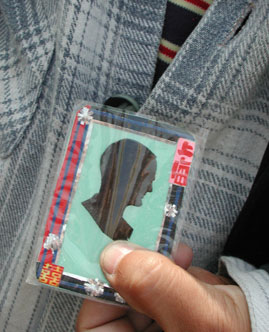 Xie
learned by watching. His apprenticeship came at the hands
of two other Bund cutters; he peered over their shoulders
as they worked.
Xie
learned by watching. His apprenticeship came at the hands
of two other Bund cutters; he peered over their shoulders
as they worked.
On an average day Xie will take in 200 yuan,
quite a nice sum considering his monthly wage from the post
office amounts to only 1,400 yuan. Given that statistics from
the Shanghai Municipal Tourism Administrative Commission show
that yearly Japanese tourist visits through July of this year
increased by sixty-six percent over the year before, it is
no surprise to hear Xie say that his business is doing better
than just a few years ago.
The reason for the tourist boom is because
Shanghai is booming; it is nearly one giant construction dig.
Cranes and scaffolding are now as common as stir-fried noodles.
The results give Shanghai a unique character.
The view from Shanghai's centrally located
People's Square park reveals surrounding buildings showcasing
wedges, arcs, half cylinders, suspended spheres, and rising
spires. At night, colorful lighting puts the architectural
puzzles on display as bicycles, taxis,
motorbikes fight for traveling space on the narrow streets
below.
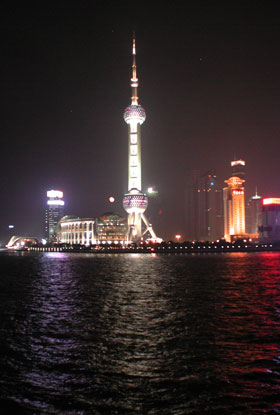 "That
used to be farmland ten years ago," says Xie, pointing
through the city's daytime haze at the disco ball-adorned
Oriental Pearl Tower, whose surrounding high-rise apartment
buildings are now receiving their finishing touches. Soon
the world's tallest building, the 95-story Shanghai World
Financial Center, will rise nearby.
"That
used to be farmland ten years ago," says Xie, pointing
through the city's daytime haze at the disco ball-adorned
Oriental Pearl Tower, whose surrounding high-rise apartment
buildings are now receiving their finishing touches. Soon
the world's tallest building, the 95-story Shanghai World
Financial Center, will rise nearby.
The boom, though, hasn't been completely smooth.
Reports of tenement housing and slums being demolished by
local officials without consent of the residents are common.
"Everyone had a better life 20 years
ago," maintains Xie, who has his Chairman Mao lapel pin
(one symbol of the Cultural Revolution of the '60s and '70s)
fastened to the underside of his hat. He notes that he has
seen an increase in family fighting and divorces over money
in recent years. "Only a small number of people are benefiting
from what is happening today."
While Shanghai continues upward - 2,000 additional
buildings over 18 stories are now in the works - Xie's goals
are a little less lofty. In addition to abandoning his scissors
in favor carefully ripping the profile shapes with the tips
of his fingers (a technique he feels he can master inside
of one year), Xie plans on expanding his language skills.
"I want to practice English so I can get
50 yuan out of the Western tourists," he laughs.
Note: Carol Tsuchida contributed to this
report from the Shanghai bureau.

